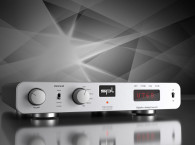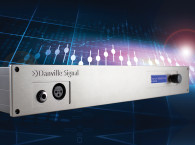
SPL electronics (its idiosyncratic non-capitalization) is a German producer of gear targeted to recording studios and prosumer users. The company’s product line is quite extensive, and includes mic preamps, recording interfaces, mixers, signal processors… about anything needed in studio electronics. SPL’s products are designed and (unusually) built in Germany, and the studio gear has (for me) a very cool appearance. Its original claim to fame was an effects device called the Vitalizer, which uses a combination of level-dependent filtering, equalization, and harmonic generation to achieve more “punch” in a mix.
But SPL is also involved in the consumer market. According to Hermann Gier, Managing Partner, “We have a strict separation between the hi-fi and the Pro Audio markets. The products of the Professional Fidelity category are designed for the hi-fi audience whereas the products within the Studio/Mastering and Plug-Ins categories are for the professional users.”
SPL’s Phonitor line comprises headphone amplifiers for both the pro and consumer markets. It starts with the Phonitor se, its entry-level consumer headphone amplifier. The Phonitor x and the Phonitor xe are the top models in that category. The Phonitor 2 is targeted for professional studio and mastering. Compared to its amplifiers targeted to the consumer market, it has further functions that are needed in production such as Solo L/R, Phase Invert L/R, as well as Center Level adjustments of the Phonitor Matrix (more about that shortly).
The item under review here is SPL’s new Phonitor One d, a combination DAC, preamp, and headphone amp for consumers, which has some interesting circuit twists. One of the technical differentiators running through SPL’s product line is its 120V circuitry, which SPL calls VOLTAIR. In a nutshell, instead of the usual ±12V to 15V power supplies common to most IC op-amp circuits, the SPL VOLTAIR products use ±60V rails. The higher power supply voltage potentially enables a larger output swing, and indeed, its studio gear runs signals up to 24dBu (about 12.3Vrms). The VOLTAIR amplifiers are used in the One d.
Product
The Phonitor One d (which I’ll just call the One d for convenience) is a solid and attractive unit (Photo 1). It has nothing of the plastic and flimsy metal of a lot of inexpensive headphone amps, but rather is solid-feeling, with an anodized black finish and a hefty all-metal case. The control knobs (volume and crossfeed) both feel velvety and luxurious in operation. The headphone output is a standard 1/4” TRS jack. Unusually (these days), the volume control here is implemented with an analog potentiometer controlling the preamplifier stage. Unlike digital control, this relies on tight matching between the potentiometer sections all through the rotational range to have stable channel-to-channel balance.
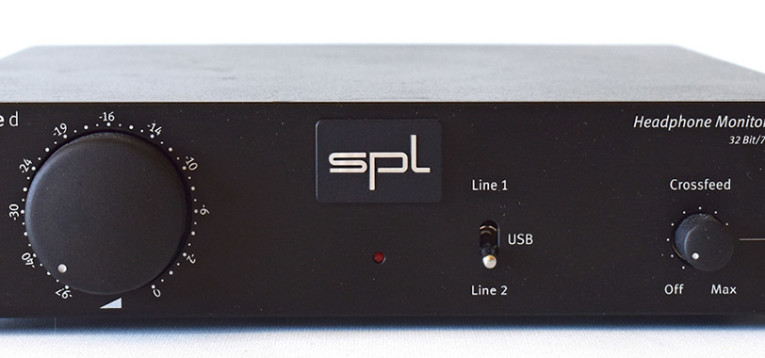
The One d has three sets of inputs — balanced and unbalanced analog and USB — selectable from the front panel with a three-way toggle switch. SPL provides an ASIO driver for the USB connection, which during my use was absolutely stable and non-buggy. The rear panel (Photo 2) has all three input source connectors—RCA phono plugs for unbalanced and TRS plugs for balanced analog, as well as the USB connector. There’s also a fixed-gain 1/4” TRS balanced analog line output. A pushbutton on-off switch and power input from the external supply complete the picture.
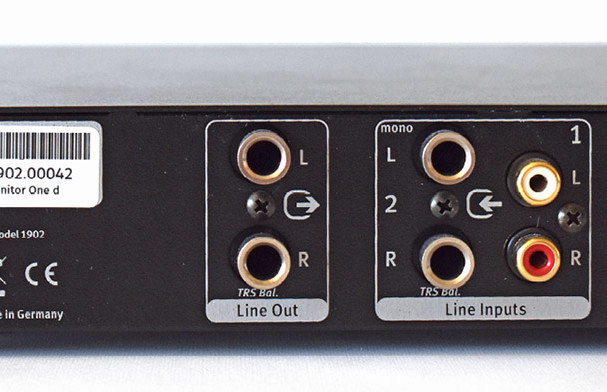
Opening the case, the quality of the innards is consistent with external impressions (Photo 3). The circuit boards are well laid out and populated with high-quality components. Op-amps used for the analog circuitry include SPL’S 120V-rated OPX for the headphone amp and the low noise and low distortion OPA2134 for the preamp. Headphone output devices appear to be paralleled MJE340/MJE350 complements. The DAC is the well-regarded 32-bit 768kHz-capable AKM AK4490EQ, from its so-called “Velvet Sound” series.
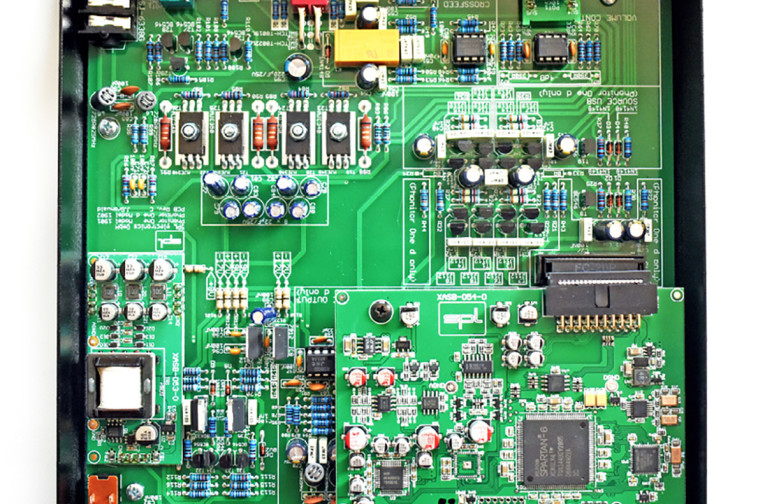
The power supplies feature active regulation, with 7812/7912 three-pin regulators for the lower voltage portions and TL783 used for the ±60V rails.
Problems to be Solved
I will start by confessing that I’m not an avid headphone user. Some really excellent ones have passed through here (most notably several versions of the Stax electrostatic headphones). The 1MORE Triple Driver Over Ear phones (see my review here), which aren’t state-of-the-art, but are still quite good, are my daily driver. And I try to take the opportunity to listen to various current high-end units at trade shows. So it hasn’t been lack of exposure to quality headphones that has relegated them to a distant second place in my heart.
How do I not love them? Let me count the ways. First, physical discomfort, but (for example) the 1MOREs seem to fit my ears nicely and are good for 2 to 3 hours before I have to rip them off my head and yell, “ENOUGH!”
Second, the imaging and soundstage follow the user’s head motion instead of being fixed with respect to his or her surroundings.
Third, headphone images seem to come from inside the user’s head, stretch unnaturally widely, and evince a weird stuffy feeling when material is pan-potted far left or right; this is all too common in the music of my youth (the 1960s and the 1970s) and so-called LCR panning on contemporary mixes.
The first objection is highly user dependent, and of course, will depend on the match between the headphone’s physical design and the user’s ears and head. Given the stubborn refusal of humans to standardize their head and pinna shapes, it will be impossible to design a universal solution, but the diversity of headphone mechanical design ensures that there’s likely to be something out there that you can comfortably wear.
The second issue can have technological solutions. Keeping the image fixed with respect to surroundings requires head tracking, but it’s been accomplished, albeit not inexpensively, by several manufacturers, most notably Smyth Research (see Resources). With modern accelerometers mass produced for cellphones, do not be surprised to see that kind of function built into headphones and amps in the next year or two.
The third issue, pan-potting sounding odd and uncomfortable, has in the past been addressed by reasonably simple approaches. There’s a fundamental difference between loudspeakers and headphones in that the left and right loudspeakers in a stereo setup are not isolated; that is, the acoustic output of the right speaker reaches both your right ear and your left ear. There is a slight timing difference due to the width of your head and the frequency response and level of the sound from the right loudspeaker impinging on your left ear has some alteration because of the acoustic effect of your noggin in the way of the sound waves (Figure 1). Of course, by symmetry, the same is true for the acoustic output of the left speaker. Because of the timing, frequency response, and level differences between channels, your brain synthesizes a stereo image.
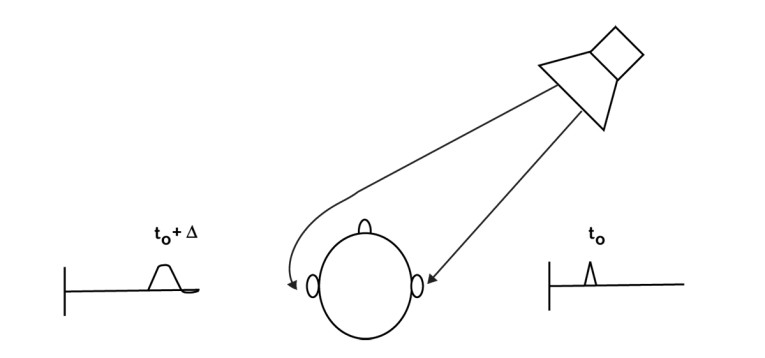
Besides the crosstalk between ears from the direct sound, unless you and your speakers are in an anechoic chamber, the room reflections also affect the mixing of channels between the ears, with even more timing, level, and frequency response alterations. This provides your brain with even more clues that the sound is emanating from outside your head and allows it to synthesize a virtual image.
By contrast, headphones completely isolate the left and the right channels, so there is a massive difference in the way the stereo image is presented to your ears, and your brain will synthesize a very different stereo presentation.
The Phonitor Matrix
In order to overcome this effect, over the years there have been many attempts to electronically create a crosstalk signal, which simulates the acoustic crosstalk inherent in speakers and rooms, while accounting for head effects. The earliest analysis and engineering solution that I’m aware of was a passive line level circuit proposed by Ben Bauer (see Resources), which added to each channel a portion of the other channel with a delay of slightly under a millisecond and some level adjustment and equalization. Over the years, this basic concept was expanded and refined by Siegfried Linkwitz (see Resources) and many others, to try to more accurately model the effect of acoustic crosstalk around your head.
A general implementation of this circuit is shown in Figure 2. The passive circuitry shown in the dashed box is meant to be generic — this is not necessarily the exact passive frequency and time-shaping circuit used in the One d, but it is a fairly common one giving similar frequency responses as the Matrix circuit used in this headphone amp. The rest of the circuit is taken from SPL’s schematics, and the op-amps used as inverting amplifiers with the crosstalk circuit sandwiched between them are, in SPL’s implementation, the high voltage VOLTAIR amplifiers.
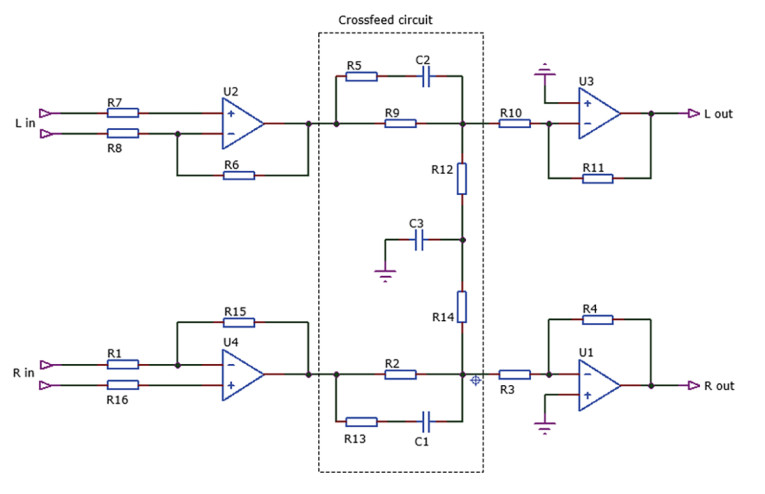
SPL claims that its Phonitor Matrix will localize sounds in the manner of loudspeakers, and even suggests that a headphone-wearing mixer can use the Matrix to allow mixing for loudspeaker playback. According to SPL, the virtual angle of the sound is equivalent to a ±30° loudspeaker spread. But this being more of a consumer product, the Matrix’s principal use would be for increased listening enjoyment from commercial recordings.
The Phonitor One d in Use
My headphones are relatively low impedance (32Ω nominal) so are something of a worst-case load, albeit with middle-of-the-road sensitivity (104dB/mW). To take them to eardrum-bursting 124dB will require 2V, so anything past that is gravy for me. With the One d, I had no problem playing music far louder than I found comfortable. Lower sensitivity headphones at similar impedances will require proportionately more drive, so when I substituted a friend’s Grado SR325s, I had to raise the volume a bit, but everything was still clean as a whistle at high volume. I was unable to borrow a real challenge like the notorious Audeze LCD-X, but I would want to try that combination before buying. For more mainstream headphones, there’s no lack of driving ability.
When it comes to electronics, I have found that the audible differences are usually so minor that they can’t easily be detected with the interference of changeover time between one component and another. So these days, if I think I hear a difference, I’ll try to confirm it using a high-resolution capture of the output to create a WAV file and compare it to the original signal with essentially instant switching using the ABX facility in DeltaWave or foobar (see Resources).
Comparing the One d to my reference DAC/headphone amp (an RME ADI-2fs b), I thought it might sound a trifle soft. Comparing WAV files via ABX, I scored 10/12 correct identifications—statistically significant, but pretty subtle. As will be shown shortly, this very slight tonal aberration will be expected to be headphone-dependent, so I would not characterize it as inherent or a means to tame any excessive treble from other headphone models.
I had a lot of fun with the Matrix control. Interestingly, with recordings that were single-point or otherwise simply miked, the effects were very subtle. For example, “Hey, Mr. Mumbles” from Clark Terry’s Live At The Village Gate (Chesky) barely altered subjectively until I reached nearly the maximum crossfeed setting. By contrast, songs like “The Jimi Hendrix Experience“ (Exp) from Axis Bold As Love (Reprise) or the Beatles’ “You Never Give Me Your Money” from Abbey Road (Universal—Apple Corps) went from almost unlistenable to absolutely delightful.
The images didn’t sound to me like they came from loudspeakers in front, but they didn’t give me the stuffed ears sensation. And instead of the hard left-right sounding like a confusing interrogation, the image was brought in subjectively closer to the sides of my head. This feature is, in my opinion, a very worthwhile one. I should mention that although this is frequency response shaping, I did not get any sense of the tonality changing with the crossfeed level. This is a problem with some crossfeed setups, and its absence is tribute to SPL’s choice of response shaping.
It should be noted that you can get plug-ins with various crossfeed features, so although the implementation here is analog electronic, you can achieve the same ends in the digital domain.
Measurements
As usual, my measurement setup comprises an Audio Precision APx-525 analyzer with an APx-1701 acoustic interface. This is backed up with a Hewlett-Packard 3466A digital multimeter, a Vicnic 1kHz precision sine wave source, and a homemade twin-T notch filter for ultra-low distortion measurement.
I started by running the One d through some basic measurements. Using the single-ended analog input, the gain to the balanced line outputs was 5.89dB and 5.91dB for left and right channels, respectively. Gain was similar using the balanced analog input. The DAC output to the fixed level balanced output was 4VRMS at 0dBFS.
The really odd measurement was the output impedance. It was relatively high at 20Ω, but flat across the audio band. I asked SPL about it to confirm I didn’t do something stupid or that there was a product defect, and they felt that the number should be much lower. SPL was kind enough to send an AP plot showing source impedance under 1Ω, but no details about the test setup. I measured it three different ways (using the AP Impedance Utility, using a voltmeter with the headphone amp at a fixed volume setting and changing the load resistance, and by attaching a reactive headphone load and seeing the frequency response variations) and got consistent results from each method. I am confident that my measurement is accurate. In general, you want the source impedance to be very low compared to the load impedance, so this was the first suggestion to me that the One d is more suitable for higher impedance headphones.
The first job of any headphone amplifier is to drive headphones! Figure 3 shows the drive capability of the One d into different impedances. For higher impedance loads, the One d is capable of sourcing about 8V before the distortion rises above 1% or so. Lower impedance loads are a bit trickier since the source impedance will limit the drive voltage via a divider effect. In this case (33R), the knee in the distortion versus drive voltage occurs between 500mV and 1V.
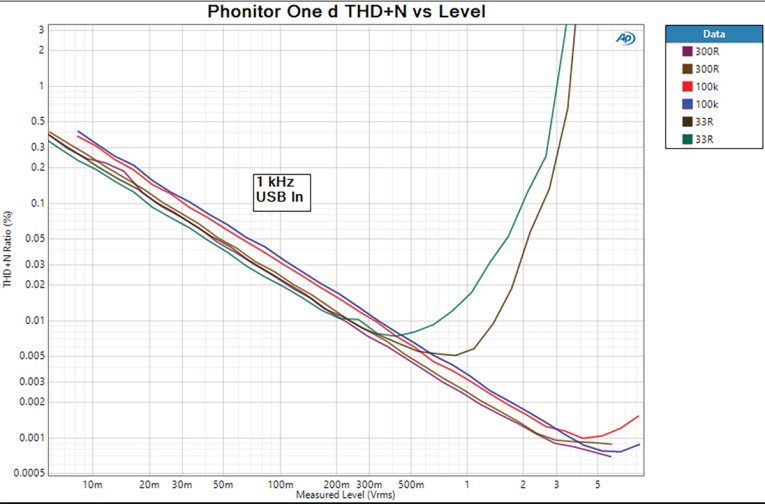

Figure 5 illustrates the output at -100dB, -110dB, and -120dB relative to full scale output. I changed the frequency a bit for each measurement in order to display the levels more easily. As can be seen in this graph, the tracking at these very low levels is essentially perfect.

The frequency response at both the balanced outputs and the headphone output was flat to within better than ±0.1dB. The impulse response is shown in Figure 6, which is typical of linear phase brick-wall filters. That type of filter is the best choice to minimize images and aliasing. A sweep of distortion versus frequency at -6dBFS is shown in Figure 7. Although it rises a bit at low frequencies, where hearing and system response are most forgiving, it remains low and the worse of the two channels is still better than 0.001%, indicating good engineering in the analog sections.

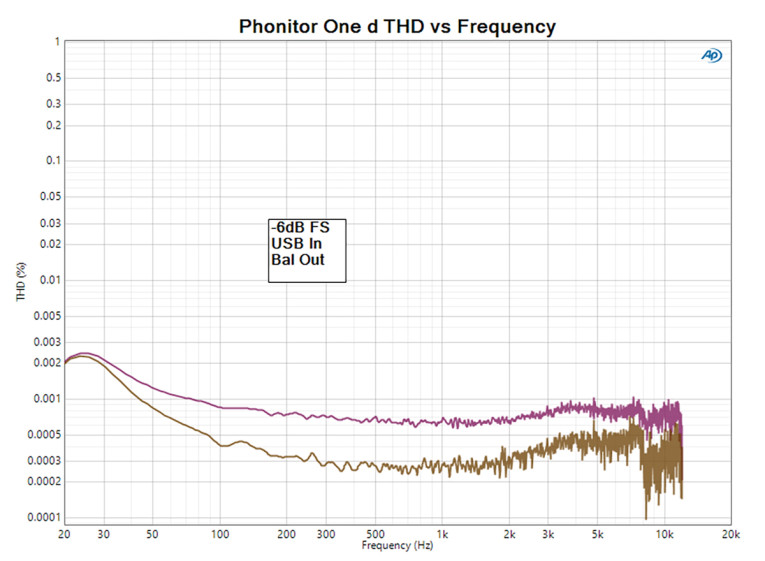
Just out of curiosity (not at all relevant to real-world use, but indicative of the engineering), I looked at the spectrum of an 80kHz signal at 2.6V from the balanced line output using the available 768kHz sampling frequency (Figure 8). Although not as beautifully clean as the performance in the audible band, the distortion still remained better than -80dB (0.01%). And it shows good performance from the circuitry at the highest sample rates relevant only to bats.
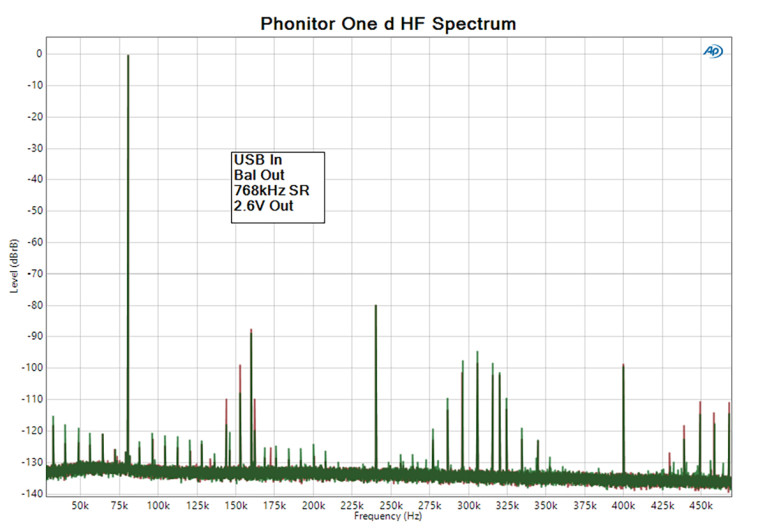
The Matrix circuit is clearly of interest here. I made several measurements of its functioning by injecting signals into one channel, then looking at the output of both. Figure 9 shows the time-domain output from a sine wave injected into the left channel (blue) and the right channel (red) undriven, with crossfeed at the fully on position.

Besides the reduced amplitude of the crossfed signal, the delay is also evident, a bit under 0.1ms at this frequency. Sweeping the frequency, the interchannel phase is shown in Figure 10 at 50% and full crossfeed. The turnover frequency increases with increasing crossfeed, but in both cases, the asymptotic phase shift is 90°, giving some clues as to the reactive crossfeed circuit.

Similarly, the frequency response with the crossfeed at 50% (dashed lines) and 100% (solid lines) is shown in Figure 11. Note that at full crossfeed, there’s less than 3dB difference between main signal and crossfeed below 1kHz or so.

Also note that the spectral balance is maintained by increasing the main channel’s treble to compensate for the treble roll-off in the crossfeed. As I observed earlier, to my ears, this is done very successfully.
Finally, I checked the frequency response into a real-world load, specifically my headphones. This is shown in Figure 12. The change in frequency response from flat is due to the voltage divider effect between the One d’s source impedance and the non-constant impedance of the headphones as a function of frequency. This correlates with the very slightly audible softening in the treble that I observed. Of course, with other headphones, this response will look quite different, and for 300Ω nominal headphones, the frequency response aberrations are likely to be well below a human’s detection threshold.

Wrap-Up
The Phonitor One d is a solidly put together unit offering an excellent DAC. The headphone amp portion works essentially perfectly for loads of 300Ω or higher, but its relatively high source impedance limits the drive to low impedance headphones, and will cause the unit to have a load-dependent sonic signature with low impedance headphones. Even so, distortion performance is well below any audible detection thresholds, and the available drive is sufficient to take most headphones to ear-splitting levels.
The Matrix circuitry is very effective at removing the “stuffed ears” effect in recordings where the production is enthusiastic about pan-potting, but falls short of the ideal of removing in-head localization. The ASIO drivers are stable and bug-free.
At $799, it is not inexpensive, but the overall performance is excellent and the construction and track record of SPL promises high reliability. If I were an avid headphone user, the One d would be on my short list of DAC/amplifier options. aX
Resources
SPL (Sound Performance Labs - SPL Electronics Gmbh) - www.spl.audio
B. Bauer, “Stereophonic Earphones and Binaural Loudspeakers,” Journal of the Audio Engineering Society (JAES) Volume 9, Number 2, pp. 148-151; April 1961.
“DeltaWave Audio Null Comparator,” https://deltaw.org
J. Didden and S. Yaniger, “The Smyth Realiser A8,” Linear Audio, Volume 7, pp. 199-206, March 2014.
“foobar2000 ABX Comparator,”
www.foobar2000.org/components/view/foo_abx/releases
S. Linkwitz, “Improved Headphone Listening,” Audio, pp. 42-43, December 1971, www.linkwitzlab.com/headphone-xfeed.htm
This article was originally published in audioXpress, November 2021.





